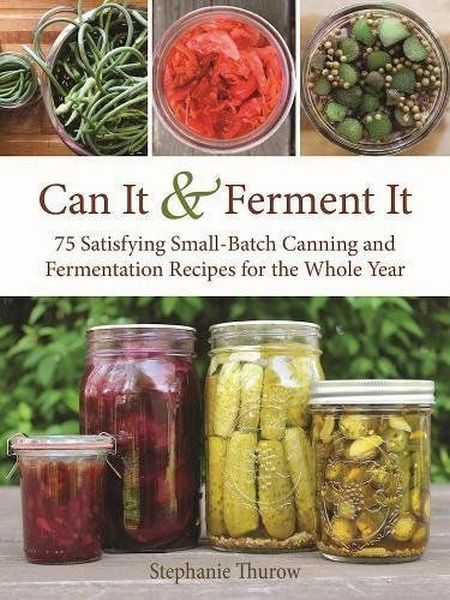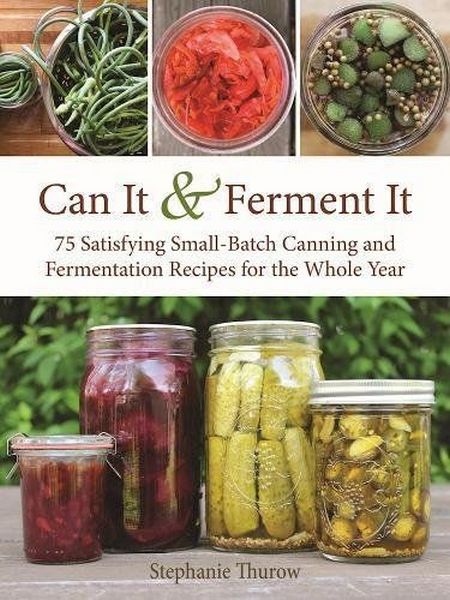Description
How to Can and Ferment - More than 75 Small-Batch Fermentation Recipes for the Whole Year
Book by Stephanie Thurow
Here we have a canning and fermentation recipe book that is more than just what the title suggest. The author, Stephanie Thurow, gets into great detail about the differences between these two key processes of food preservation.Canning and Fermentation
Water bath canning makes sure you preserve your canned food with all its freshness and flavor after going through the high heat process of a boiling water bath. This method results in an airtight, high acid environment, safe from bacteria and other contaminants that may be harmful to your batch. Canning of fruits and vegetables thus preserves foods and makes them shelf-stable, perfect to be stored in the pantry or on the cupboard for up to a year.
Fermentation is a bit different. We’ve already discussed the fermentation method in our blog posts. It in involves storing healthy veggies, fruits and other foods in salt or saltwater brine. The process creates an acidic environment by converting sugar into acid in which harmful and unsafe bacteria cannot survive. As we’ve discussed in our blog posts, this process is commonly referred to as lactic-fermentation and can last anywhere from a couple of days to years, depending on the desired flavor and fruit or vegetable used. However, the fermentation recipes detailed in this great book take only a few days/weeks to complete.
Importance of Local and Organic
One other major aspect of this valuable resource is stressing the importance of local and organic produce. Naturally preserved foods are much healthier than their store-bought counter parts. However, your canned vegetables or fermented goods are only going to be as good as your fresh veggies or fruits are. So make sure you get the best available ones: pick, or buy them from a reputable source at their peak. This way they will retain more of their nutritional values than any home-made batch prepared with less-than optimal raw ingredients.
The book examines why it is important to avoid the mistake of major retailers who pick their vegetables and fruits before they’re ripe. It also goes into some detail as to why it is important to have ingredients that are not treated with a food-grade-wax sealant or harsh chemicals, picking fruits and veggies that are not bruised, and that are uniform in size. Having similar sized products allows them to pickle and ferment evenly, resulting in a consistent and a delicious, healthy homemade product.
Tools and Utensils
You will also learn about the utensils required for your basic batch. Proper cutting and shredding tools are very important for the success of your homemade ferment. But, don’t be intimidated! You might simply need a mandolin slicer or just a plain old-fashioned vegetable shredder or even a large cabbage shredder . They will allow you to easily shred your veggies into uniformly thin slices, ensuring an even fermentation process.
Detailed and Easy Recipes with Illustrations
The recipes are simple and easy to follow, with useful photos of the process. Stephanie is very detailed, yet concise, and in her recipes she focuses on the important and leaves out the irrelevant. You will quickly learn how to prepare a wide variety of delicious homemade health foods. Just follow the easy, step-by-step fermentation and canning guide. All the recipes are illustrated with very useful photos of all the crucial kitchen utensils, ranging from crocks and mason jars all the way to wooden cabbage shredders . The pictures also show how to cut, shred, boil and pack your fruits and vegetables to ensure a perfect preservation process.The book has all the basic and even some state-of-the-art homemade recipes. They are gathered through Thurow's quest for the tastiest naturally preserved dishes, scouring such obscure resources as her mother-in-laws cookbook and grandma’s old recipes. Some of these include:
- Strawberry Chutney
- The Perfect Garlic Dill Pickle
- Spring Onion Kimchi
- Fermented Cabbage with Caraway Seeds (an interesting version of the sauerkraut variant we have extensively written about)
- Napa Cabbage Kimchi (we have a fantastic piece on Kimchi right here )
- Grandma’s Pickled Beets
- Pickled Jalapeno Slices
- Cinnamon-honey Apple Butter
- and many more
Get Started!
This book details the benefits and all the differences between the two often confused processes: canning and fermenting. In addition to fruits and vegetables, you will also find information on fermented and canned delicacies such as eggs and fish. All in all, this book will provide you with a fine selection of recipes, whether you’re just getting ready to start your first batch, or are already a seasoned practitioner. All of the canning and fermented food recipes listed here are easy to follow and illustrated with photographs - always a huge plus.

